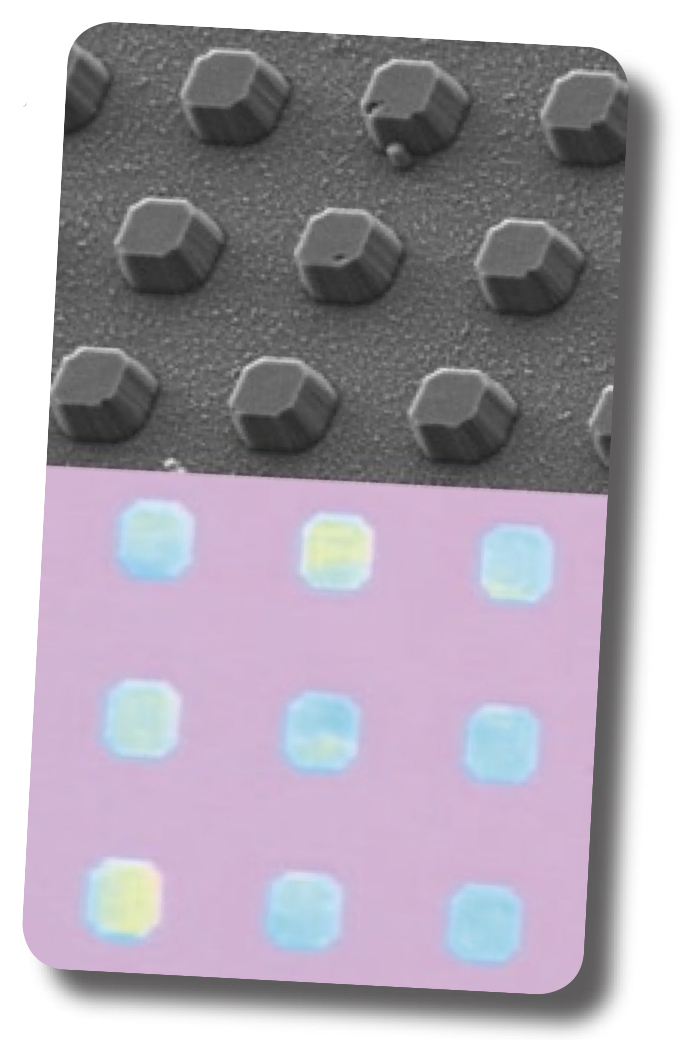Using precise computer simulations, Ohio State University researchers were able to discover potential keys to mass producing a specific pattern of graphite in a layer just one atom thick, signaling a breakthrough that could lead to "graphene" challenging silicon as the preferred material for manufacturing faster, more efficient computer chips.
 |
|
A computer model of the one-atom-thick graphene layer (gray) being stamped onto a silicon dioxide base material (orange and yellow).
|
While scientists have known of graphene for many years, electronics industry officials became particularly excited about the potential use of graphene about five years ago, when it was discovered that graphene has a number of special properties. Researchers found that thin layers of graphite - the dark gray carbon material that fills most pencils - is highly stable, visible under the right conditions even when only one atom thick, stronger than steel and conducts electricity quickly and in exceptional ways.
While several researchers have been able to deposit small samples of graphene on a base material, OSU associate professor of materials science and engineering Wolfgang Windl, Ph.D., and his colleagues wanted to develop a method for producing very accurate, very position-specific graphene patterns in a way that industry could use to manufacture computer chips from this novel material.
To do this, the OSU team wanted to etch their graphite samples to create numerous miniature "pillars" that then would be lightly pressed on a base material or "substrate." When the graphite was pulled away, they theorized, the silicon dioxide substrate would adhere to the graphite, forcing a very thin top layer to shear off from the pillars.
To confirm their theory, Windl turned to the high performance computing systems of the Ohio Supercomputer Center (OSC) and the Vienna Ab-initio Simulation Package, a software package for simulating the properties of systems at the atomic scale.
“The calculations are computationally very demanding for the systems under consideration due to their size and complexity, and they couldn’t have been done without our allotment at the Ohio Supercomputer Center,” Windl explained. “Based on our initial success with these computer simulations, we currently model adhesion on different substrates along with the resulting electrical transport through the graphene to optimize the stamping process and the resulting devices.”
“Dr. Windl ran his jobs on OSC’s flagship supercomputer system, known as the Glenn Cluster, ” explains Jim Giuliani, client and technology support manager at OSC. “The Glenn Cluster offers registered users 24 terabytes of memory and a peak computational capability of 75 teraflops – which translates to about 75 trillion calculations per second.
“OSC also provides researchers with a wide library of powerful computational and visualization software packages. By using a software package designed for parallel computing systems, Dr. Windl was able to leverage dozens of processors to run his jobs, allowing him to obtain his results in a fraction of the time that an ordinary workstation solution would require.”
With confirmation from their computer models, Windl and his colleagues from OSU’s Center for Emergent Materials then entered the laboratory to physically test those results. They were successful in shearing off layers of graphite that were about ten atoms thick and are in the process of obtaining a patent on the technique.
“We have shown that site-specific stamping of patterned few-layer graphene is feasible from the scientific point of view,” they reported in an article for the journal Advanced Materials. “The site-specific nature of the stamps will allow the production of electrical contacts to the stamps as a whole by depositing metal electrodes using existing lithographic methods, paving the way for possible high-throughput fabrication of graphene-based integrated devices in the future.”
________________
The Ohio Supercomputer Center is a catalytic partner of Ohio universities and industries that provides a reliable high performance computing infrastructure for a diverse statewide/regional community. OSC promotes and stimulates computational research and education in order to act as a key enabler for the state's aspirations in advanced technology, information systems, and advanced industries. For additional information, visit http://www.osc.edu